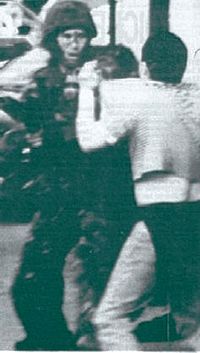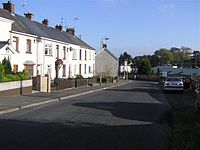- 1992 Coalisland riots
-
1992 Coalisland riots Part of The Troubles and Operation Banner 
A British paratrooper confronts a Coalisland resident
(May 1992)Date 12 and 17 May 1992 Location Coalisland, County Tyrone,
Northern Ireland
54°32′25.46″N 6°42′09.36″W / 54.5404056°N 6.7026°WCoordinates: 54°32′25.46″N 6°42′09.36″W / 54.5404056°N 6.7026°WResult - Parachute Regiment patrols in Northern Ireland canceled before official tour's end
- Commanding officer of Northern Ireland's Third Brigade removed
Causes Provisional IRA attack on British army patrol near the village of Cappagh, County Tyrone Parties to the civil conflict Coalisland residents  British Army
British ArmyCasualties 3 hospitalized,
at least 4 others injured2 soldiers hospitalized Another soldier lost his legs during the previous PIRA bomb attack at Cappagh The 1992 Coalisland riots were a series of clashes on 12 and 17 May 1992 between local nationalist civilians and British Army soldiers (of the Third Battalion of the Parachute Regiment[1] and the King's Own Scottish Borderers) in the town of Coalisland, County Tyrone, Northern Ireland. The Third Battalion 1992 tour's codename was "Operation Gypsy".[2]
Contents
Provisional IRA attack
On 12 May 1992, a unit of the Provisional Irish Republican Army (IRA) East Tyrone Brigade launched a bomb attack on a British Army patrol near the republican stronghold of Cappagh, County Tyrone. One soldier of the Parachute Regiment lost both legs as a result. The landmine was described in an IRA statement as an "anti-personnel device".[3] This incident triggered a rampage by members of the Parachute Regiment in the nearby, predominantly nationalist town of Coalisland.[4][3] The deployment of the paratroopers, which began in April[1][5] had already been criticized by republican activist Bernadette Devlin McAliskey, who denounced the rising number of beatings, shootings and damages to property carried out by these troops.[6] Ken Maginnis, then-MP for the area, called for the withdrawal of the regiment, after receiving a large number of complaints about their behaviour.[3][7]
The confrontation
12 May
Two hours after the IRA attack, members of the regiment sealed off the town of Coalisland, ten miles east of Cappagh. According to a Social Democratic and Labour Party politician, the soldiers fabricated a bogus bomb warning, while the RUC claimed that the operation began when a joint patrol was stoned by the crowd.[8] Two pubs were ransacked by the troops[9] and a number of civilian cars were damaged. Several people were allegedly hit with sticks. Following this, a lieutenant was suspended from duty[3] and the regiment was removed from patrol duties in Coalisland.[10]
17 May
On the evening of 17 May, a fist-fight began at Lineside Road, where a group of young men were having a drink. A passing four-man patrol of the King's Own Scottish Borderers (KOSB) regiment was defied to a 'boxing match' by the residents; apparently a common practice according to Bernadette McAliskey.[6] The soldiers set aside their weapons and engaged the youths who, after a brief clash, forced the soldiers to take shelter at the local RUC station. The official claim was that the patrol was attacked by a mob. In the melée, a rifle and a light machine gun were stolen. The rifle was later recovered nearby.[10] Two KOSB soldiers had to be hospitalized.[3] The Parachute Regiment was called to the scene again, and at 8:30 PM, a major riot started outside Rossmore pub. The soldiers claimed that one of their colleagues was isolated and dragged by the crowd. Some witnesses claimed the paratroopers were in a frenzy, showing their guns and inviting the civilians to take them. Suddenly, shots were fired by the troops —first into the air and then towards the people outside the pub. Three civilians were rushed to hospital in Dungannon with gunshot wounds, while the soldiers returned to their barracks.[10] Another four civilians suffered minor injuries.[9]
Aftermath
About 500 people attended a protest rally in Coalisland some days later, and the wisdom of deploying the troops to patrol the town was questioned by members of the Dáil in Dublin. The Minister of Foreign Affairs of the Republic of Ireland, David Andrews, asked the British Government to withdraw the regiment. As a result, the paratroopers were redeployed outside the urban areas.[11][12] The RUC claimed that the stolen machine gun was found 11 days later at Cappagh, along with another light machine gun and an AK-47 rifle.[13] Republicans questioned the stealing of the weapon, suggesting this was merely an excuse for the Army rampage at Coalisland.[6] Unionist officials accused Sinn Féin of being the instigators of the riots,[8] while Michael Mates, then Minister of State at the Northern Ireland Office, stated that the incidents were due to "a gang of thugs motivated by the IRA".[14] Eventually the battalion's 1992 tour in Northern Ireland was scaled down, with the patrols suspended before the official end of the deployment. The Third Brigade's commander, Brigadier Tom Longland[5] was dismissed.[9][12][15][16] Near the end of the tour, the soldiers were involved in the beating of two men in Cappagh and Dungannon, according to a republican source.[17] The last patrol took place on 27 June, when two paratroopers drowned while crossing a river.[18][19] The same day, there were further clashes with local residents, this time in Cookstown.[20] Six soldiers faced criminal charges for the May riots,[21][9] but were acquitted one year later. Five of them were bound over.[22] The incident stirred memories of the regiment's actions on Bloody Sunday, whose 20th anniversary was marked in 1992.[10]
See also
- Clonoe ambush
- 1997 Coalisland attack
Notes
- ^ a b The economist, Volume 323, Issues 7761-4
- ^ British Army 1945 on locations and dates
- ^ a b c d e The Irish Emigrant, "New Paratroop controversy", 18 May 1992
- ^ "British troops launch charm attack in Belfast", by Peter Millership, Reuters, 8 August 1993
- ^ a b Irish America (1992), Irish Voice, Inc., volume 8
- ^ a b c "British army terrorises Irish town", Green Left, 1 July 1992
- ^ Kennedy-Pipe, Caroline (1997). The origins of the present troubles in Northern Ireland. Longman, pg. 164; ISBN 0582100739
- ^ a b Wood, Ian S. (1994). Scotland and Ulster. Mercat Press, pg. 161; ISBN 1873644191
- ^ a b c d CAIN -1992 chronology
- ^ a b c d Fortnight issues 302-12, Fortnight Publications, 1992, pg. 6
- ^ The Irish Emigrant, "Paratroopers remain in North", 25 May 1992
- ^ a b Wood, Ian S. (1994). Scotland and Ulster. Mercat Press, pg. 61; ISBN 1873644191
- ^ Fortnight, issues 302-12, Fortnight Publications, 1992, pg. 24
- ^ House of Commons, Thursday, 21 May 1992
- ^ Bew, Paul (1999). Northern Ireland: a chronology of the troubles 1968-1999. Gill & Macmillan, pg. 260; ISBN-10: 0717129268
- ^ "British Take Paratroopers Off Ulster Security Detail", by Alexander McLeod. The Christian Science Monitor, 28 May 1992
- ^ Saoirse Irish Freedom, issue 63, July 1992
- ^ Operation Banner Deaths - Roll of Honour
- ^ Paras - Roll of Honour
- ^ CAIN - Listing of Programmes for the Year: 1992 - UTV news, 27 June 1992
- ^ The Independent, 29 September 1992
- ^ Fortnight, Issues 324-34, Fortnight Publications, 1994
The Troubles Participants in the Troubles Chronology Political Parties Republican
paramilitariesSecurity forces of the United Kingdom
Loyalist
paramilitaries• Ulster Defence Association
• Ulster Volunteer Force
• Loyalist Volunteer Force
• Red Hand Commandos
• Young Citizen Volunteers
• Ulster Young Militants
• Ulster Resistance
• UVF Mid-Ulster Brigade
Linked to
• Some RUC and British Army members• Northern Ireland Civil Rights Association formed (1967)
• Battle of the Bogside (1969)
• Riots across Northern Ireland (1969)
• Beginning of Operation Banner (1969)
• Social Democratic and Labour Party formed (1970)
• Internment without trial begins with Operation Demetrius (1971)
• Bloody Sunday by British Army (1972)
• Northern Ireland government dissolved. Direct rule from London begins (1972)
• Bloody Friday by Provisional IRA (1972)
• Power sharing Northern Ireland Assembly set up with SDLP and Ulster Unionist Party in power (1973)
• Mountjoy Prison helicopter escape. Three Provisional IRA prisoners escape from Mountjoy Prison by helicopter (1973)
• Ulster Workers' Council strike causes power-sharing Northern Ireland Assembly to end (1974)
• Dublin and Monaghan bombings by UVF with alleged British Army assistance (1974)
• Kingsmill massacre by South Armagh Republican Action Force (1976)
• Warrenpoint Ambush by Provisional IRA (1979)
• 1981 Irish hunger strike by Provisional IRA and INLA members (1981)
• Hunger striker Bobby Sands elected MP. Marks turning point as Sinn Féin begins to move towards electoral politics (1981)
• Maze Prison escape. 38 Provisional IRA prisoners escape from H-Block 7 of HM Prison Maze (1983)
• Brighton hotel bombing by Provisional IRA (1984)
• Anglo-Irish Agreement between British and Irish governments (1985)
• Remembrance Day bombing by Provisional IRA (1987)
• Peace Process begins (1988)
• Operation Flavius, Milltown Cemetery attack and Corporals killings (1988)
• Bishopsgate bombing (1993)
• Downing Street Declaration (1993)
• First Provisional IRA ceasefire (1994)
• Loyalist ceasefire (1994)
• Docklands bombing (1996)
• 1996 Manchester bombing (1996)
• Second Provisional IRA ceasefire (1997)
• Good Friday Agreement (1998) signals the end of the Troubles
• Assembly elections held, with SDLP and UUP winning most seats (1998)
• Omagh bombing by dissident Real IRA (1998)• Unionist parties:
• Democratic Unionist Party
• Northern Ireland Unionist Party
• Ulster Unionist Party
• Progressive Unionist Party
• Conservative Party
• UK Unionist Party
• Traditional Unionist Voice
• Nationalist parties:
• Democratic Left
• Fianna Fáil
• Fine Gael
• Labour Party
• Progressive Democrats
• Sinn Féin
• Social Democratic & Labour Party
• Workers' Party of Ireland
• Irish Republican Socialist Party
• Republican Sinn Féin
• Cross-community parties:
• Alliance Party
• Historically important parties:
• Nationalist Party
• Northern Ireland Labour Party
• Protestant Unionist Party
• Vanguard Unionist Progressive Party
• Northern Ireland Women's Coalition
• People's Democracy
• Republican Labour Party
• Anti H-Block
• Irish Independence Party The Troubles at Wiktionary ·
The Troubles at Wiktionary ·  The Troubles at Wikibooks ·
The Troubles at Wikibooks ·  The Troubles at Wikiquote ·
The Troubles at Wikiquote ·  The Troubles at Wikisource ·
The Troubles at Wikisource ·  The Troubles at Commons ·
The Troubles at Commons ·  The Troubles at WikinewsCategories:
The Troubles at WikinewsCategories:- Coalisland
- Riots and civil disorder in Northern Ireland
- Protests in Northern Ireland
- 1992 in Northern Ireland
- 1992 riots
- Conflicts in 1992
- Provisional Irish Republican Army actions
- The Troubles in County Tyrone
- Military history of County Tyrone
- Military scandals
- Parachute Regiment (United Kingdom)
- Battles and conflicts without fatalities
- Urban warfare
- Parachute Regiment patrols in Northern Ireland canceled before official tour's end
Wikimedia Foundation. 2010.

